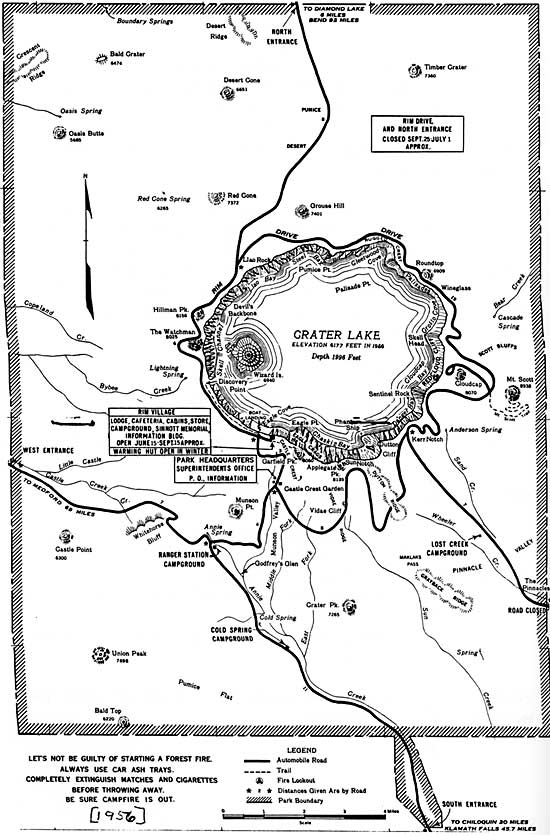Large numbers of tourists were attracted to Crater Lake during the winter of 1949 when the lake froze over for the first time in recorded history. The lake was solidly frozen to depths ranging from 2 to 12 inches and snow-covered from February to April. The freeze aroused “widespread interest,” and, according to the Annual Report of the Director of the National Park Service, “visitors to the park, many of whom were attracted there by this unusual occurrence, beheld an expanse of white in place of the sapphire waters so justly famous.” [56]
Increasing amounts of leisure time, higher levels of income, and improved transportation-related facilities contributed to rising park visitation during the 1950s. The annual average for the decade was more than one-third million, the totals ranging from a low of 306,668 in 1951 to a high of 370,554 in 1954. This rising visitation was encouraged by increasing exposure of the park in national travel periodicals such asTravel and Sunset. The growth in visitation led to innovations in entrance checking procedures, the most significant being issuance of entrance permits by machine in 1953.[57]
During the summer of 1950 a survey was conducted by the U.S. Department of the Interior at Crater Lake National Park and Oregon Caves National Monument. The purpose of the survey was to determine tourist expenditures and travel occasioned by the two areas and examine the economic impact that they had in the general economy of the Rogue River Basin. The study provided a statistical breakdown of the travel flow through the park:
| Entering | Entering | Leaving | Total |
| North | 133,699 – 43.2% | 114,820 – 37.1% | 248,519 – 40.1% |
| East | 3,095 – 1.0% | 16,403 – 5.3% | 19,498 – 03.2% |
| South | 86,657 – 28.0% | 82,943 — 26.8% | 169,600 – 27.4% |
| West | 86,037 – 27.8% | 95,322 – 30.8% | 181,359 – 29.3% |
Other data obtained by the study included:
a. 87% planned in advance to visit the park.
b. The park was the principal objective of 63.4%.
c. 83% spent one day or less in the park.
d. 17% stayed overnight and remained an average 1.2 days in the park.
e. 14.1% reported a visit to Oregon Caves National Monument.
Vacation travel resulted in an expenditure of $3,945,000 within the southwestern section of Oregon. [58]

Most of the concessioners were disturbed by some of the new policies and the new form of contract adopted by the Service. Many felt insecure in their investment and their chances of continuing in operation. As a result, there was little effort made for improving existing facilities or constructing new ones. Now that many of the policy features that were questioned have been satisfactorily adjusted, closer cooperation between the National Park Service and its concessioners is to be expected.
The Crater Lake National Park Company finally completed its fire protection improvements at Crater Lake lodge at the beginning of the 1949 season, and these improvements together with the better control of the watchman service provided a reasonable protection to Crater Lake lodge and its guests.
The company was officially advised last winter that it might continue to operate the lodge for the duration of its contract period, which extends for another twelve years, but conditional on the installation of an automatic sprinkling system. If this project is carried out, the National Park Service will have to share the project because the furnishing of an adequate water supply at all times is one of the first and most essential requirements. [59]
During 1950-51 relations between the Crater Lake National Park Company and the traveling public, Park Service, and company employees “reached a new low.” Superintendent Leavitt noted, however, that there had been a “lack of cooperation on the part of the company with the National Park Service” for many years. A special effort to improve these conditions was undertaken on May 7, 1951, at a meeting held in Portland with NPS and company officials in attendance. As a result assurances were given by the company “that every effort would be made at once to improve relations” in the aforementioned three problem areas. [60]

